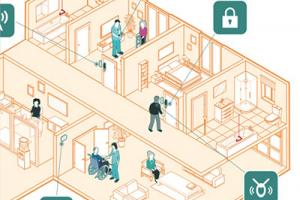Connected care and health solutions provider Tunstall Healthcare has launched an innovative and revolutionary nurse call system, Tunstall Carecom…
Improving residential care through digital transformation
Colin Yates, chief support officer at WorkMobile – an award-winning mobile data capture solution – discusses the links between going paperless and the quality of residential care.
Over the past few years, digital transformation has become an increasingly hot topic in business circles. There is a very good reason for this: done well, digital transformation drives efficiency and improves productivity, saving a business both time and money.
Enterprises in almost all industries stand to benefit from their own digital transformation projects, and the residential care home sector is no exception. The question is, what would this look like?
At its most basic level, digital transformation is the use of digital technologies to solve traditional problems. So, there is a need to identify which areas of a business have historically proved challenging and could be improved by incorporating new technology such as cloud computing, artificial intelligence and the Internet of Things. 
Residential care homes are often very reliant on paper-based processes. From care plans and risk assessments, to safeguarding reports and health assessments, there is inherently a lot of paperwork involved in the day to day running of a care home business, and given that there didn’t use to be an alternative to physical documentation, many have continued to operate with traditional processes.
However, a heavy reliance on paper can cause significant problems. If essential paperwork is not completed and filed in a timely and correct manner, this can lead to standards of care slipping and concerns being raised by the CQC. As a result, some forward-thinking care home operators have begun their digital transformations by implementing cloud-based electronic care record software.
This type of software has the ability to completely eliminate the need for paper, with all documents being completed digitally instead, often via an app on a mobile device or tablet. The information in these documents can then be saved automatically to a central reporting platform, that can be accessed instantly by all authorised members of staff, wherever they’re based.
Modernising care home businesses by going paperless can have a host of wide-reaching benefits for all of those involved.
Care workers
For staff working on the front lines, outdated paper-based processes create an unnecessary administrative burden. Completing all paperwork by hand takes time, and each document must then be filed away carefully. In some cases, the information in this paperwork is also manually inputted into a digital database, taking up even more time and being open to errors.
With digital alternatives, documents can be accessed much more easily and filled in much more quickly, with no need for any time to be spent on filing. Information can be recorded in real time as staff go about their duties, meaning that data held about residents is more likely to be complete and accurate. Where appropriate, certain sections can also be pre-populated to save time and unnecessary repetition.
This means that care workers don’t have to worry about having to stay late after their shift to complete outstanding admin tasks, offering them a better work-life balance and giving them more time to concentrate on providing the best possible service to those in their care.
Residential care home operators
For care home operators, one of the main benefits is a significant reduction in operational costs. Relying on paper-based processes is expensive, with one study suggesting that it can cost even a very small business as much as £14,616 each year. Implementing a digital care record solution can greatly decrease ongoing expenses, by minimising or even eliminating the need for paper, printers and physical storage.
One major problem caused by relying on paper-based processes is that it can be difficult to ensure the confidentiality of patient information. Digital solutions can allow management to set permissions dictating who has access to which levels of information saved on the system. For care homes that experience a high turnover of carers, or rely heavily on agency staff, this is an easy and effective way to protect patient confidentiality.
It can also be extremely difficult to keep large amounts of paperwork organised. This makes it much more likely that important documents will be filed incorrectly or misplaced altogether. Missing paperwork puts patients at risk, and leaves care providers vulnerable to compliance issues which could negatively affect their CQC rating.
Digital systems eliminate this issue, while also making it much easier for staff to interrogate previous reports and see any outstanding tasks. With this additional safety net, care home operators can feel confident that they are providing the best possible quality of care and meeting the CQC’s high standards.
It’s clear that embracing digital transformation is a relatively simple way to overhaul a care business. Just by going paperless, it’s possible to improve working conditions for staff, reduce costs, and increase CQC compliance, making it worth serious consideration for care home operators looking to improve their excellent standards of care.
For more information on Improving residential care through digital solutions, visit www.workmobileforms.com


